Exploring Venture Types and Impact on Small Business Management
VerifiedAdded on 2023/04/05
|17
|3619
|254
Essay
AI Summary
This essay provides a comprehensive overview of entrepreneurship and small business management. It begins by exploring various venture types, including scalable startups, social entrepreneurship, small business entrepreneurship, and large company entrepreneurship, highlighting their unique characteristics and contributions. The essay then assesses the impact of small businesses on the economy, focusing on factors such as job creation, innovation, and community development. It also examines the key aspects of an entrepreneurial mindset, emphasizing the importance of opportunity recognition, risk-taking, and innovation. Finally, the essay explores different environments that foster or hinder entrepreneurship, considering factors such as government policies, access to capital, and cultural attitudes. The document is available on Desklib, a platform offering study tools and solved assignments for students.

University
ENTREPRENEURSHIP AND SMALL BUSINESS MANAGEMENT
By
Date
Name
Lecturer’s Name
ENTREPRENEURSHIP AND SMALL BUSINESS MANAGEMENT
By
Date
Name
Lecturer’s Name
Paraphrase This Document
Need a fresh take? Get an instant paraphrase of this document with our AI Paraphraser

ENTREPRENEURSHIP AND SMALL BUSINESS MANAGEMENT
Contents
Task 1..........................................................................................................................................................3
Explore and illustrate the range of venture types that might be considered entrepreneurial....................3
Task 2..........................................................................................................................................................6
Assess the impact of small businesses on economy.................................................................................6
Task 3........................................................................................................................................................10
Determine and assess the key aspects of an entrepreneurial mindset.....................................................10
Task 4........................................................................................................................................................12
Examine the different environments that foster or hinder entrepreneurship..........................................12
References.................................................................................................................................................15
Page 2 of 17
Contents
Task 1..........................................................................................................................................................3
Explore and illustrate the range of venture types that might be considered entrepreneurial....................3
Task 2..........................................................................................................................................................6
Assess the impact of small businesses on economy.................................................................................6
Task 3........................................................................................................................................................10
Determine and assess the key aspects of an entrepreneurial mindset.....................................................10
Task 4........................................................................................................................................................12
Examine the different environments that foster or hinder entrepreneurship..........................................12
References.................................................................................................................................................15
Page 2 of 17
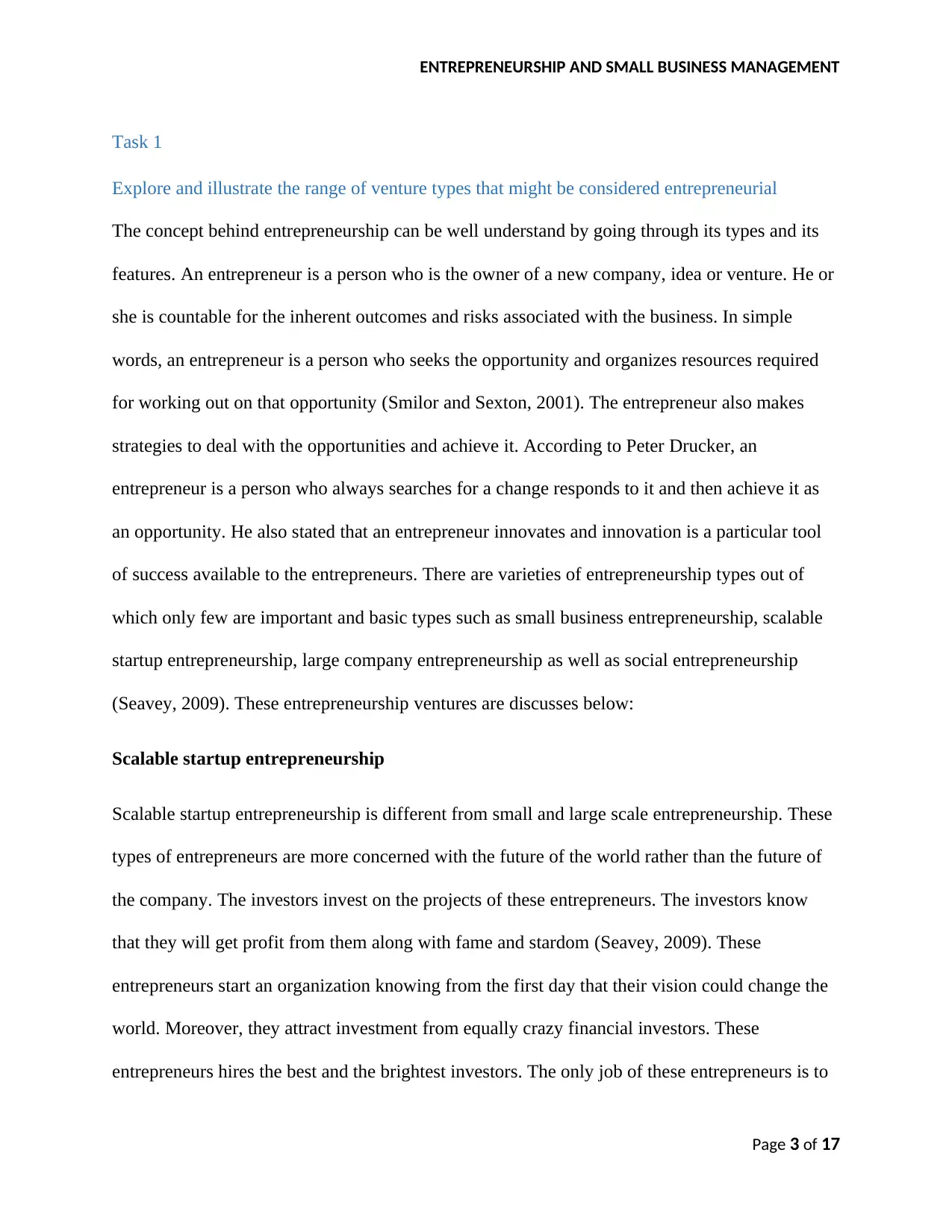
ENTREPRENEURSHIP AND SMALL BUSINESS MANAGEMENT
Task 1
Explore and illustrate the range of venture types that might be considered entrepreneurial
The concept behind entrepreneurship can be well understand by going through its types and its
features. An entrepreneur is a person who is the owner of a new company, idea or venture. He or
she is countable for the inherent outcomes and risks associated with the business. In simple
words, an entrepreneur is a person who seeks the opportunity and organizes resources required
for working out on that opportunity (Smilor and Sexton, 2001). The entrepreneur also makes
strategies to deal with the opportunities and achieve it. According to Peter Drucker, an
entrepreneur is a person who always searches for a change responds to it and then achieve it as
an opportunity. He also stated that an entrepreneur innovates and innovation is a particular tool
of success available to the entrepreneurs. There are varieties of entrepreneurship types out of
which only few are important and basic types such as small business entrepreneurship, scalable
startup entrepreneurship, large company entrepreneurship as well as social entrepreneurship
(Seavey, 2009). These entrepreneurship ventures are discusses below:
Scalable startup entrepreneurship
Scalable startup entrepreneurship is different from small and large scale entrepreneurship. These
types of entrepreneurs are more concerned with the future of the world rather than the future of
the company. The investors invest on the projects of these entrepreneurs. The investors know
that they will get profit from them along with fame and stardom (Seavey, 2009). These
entrepreneurs start an organization knowing from the first day that their vision could change the
world. Moreover, they attract investment from equally crazy financial investors. These
entrepreneurs hires the best and the brightest investors. The only job of these entrepreneurs is to
Page 3 of 17
Task 1
Explore and illustrate the range of venture types that might be considered entrepreneurial
The concept behind entrepreneurship can be well understand by going through its types and its
features. An entrepreneur is a person who is the owner of a new company, idea or venture. He or
she is countable for the inherent outcomes and risks associated with the business. In simple
words, an entrepreneur is a person who seeks the opportunity and organizes resources required
for working out on that opportunity (Smilor and Sexton, 2001). The entrepreneur also makes
strategies to deal with the opportunities and achieve it. According to Peter Drucker, an
entrepreneur is a person who always searches for a change responds to it and then achieve it as
an opportunity. He also stated that an entrepreneur innovates and innovation is a particular tool
of success available to the entrepreneurs. There are varieties of entrepreneurship types out of
which only few are important and basic types such as small business entrepreneurship, scalable
startup entrepreneurship, large company entrepreneurship as well as social entrepreneurship
(Seavey, 2009). These entrepreneurship ventures are discusses below:
Scalable startup entrepreneurship
Scalable startup entrepreneurship is different from small and large scale entrepreneurship. These
types of entrepreneurs are more concerned with the future of the world rather than the future of
the company. The investors invest on the projects of these entrepreneurs. The investors know
that they will get profit from them along with fame and stardom (Seavey, 2009). These
entrepreneurs start an organization knowing from the first day that their vision could change the
world. Moreover, they attract investment from equally crazy financial investors. These
entrepreneurs hires the best and the brightest investors. The only job of these entrepreneurs is to
Page 3 of 17
⊘ This is a preview!⊘
Do you want full access?
Subscribe today to unlock all pages.

Trusted by 1+ million students worldwide
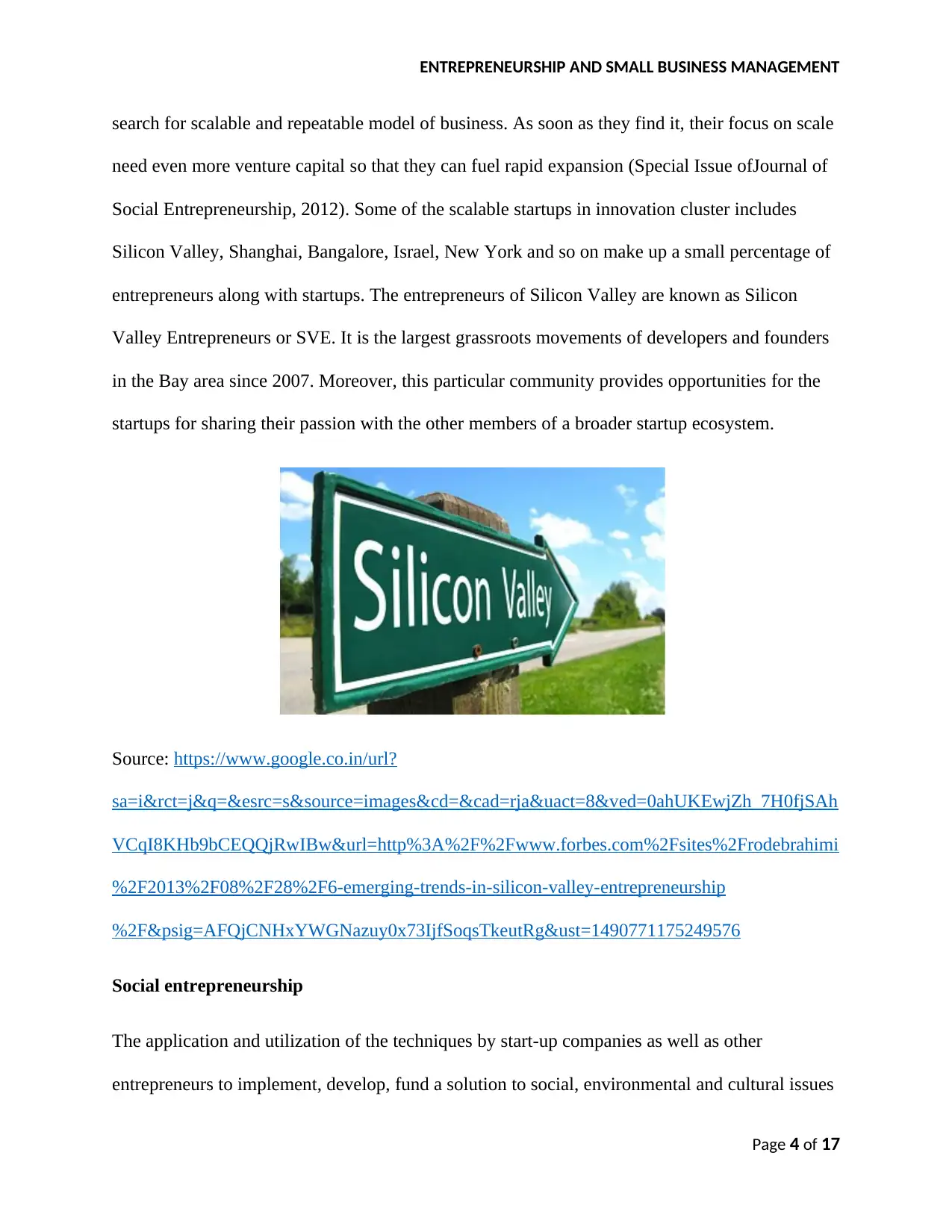
ENTREPRENEURSHIP AND SMALL BUSINESS MANAGEMENT
search for scalable and repeatable model of business. As soon as they find it, their focus on scale
need even more venture capital so that they can fuel rapid expansion (Special Issue ofJournal of
Social Entrepreneurship, 2012). Some of the scalable startups in innovation cluster includes
Silicon Valley, Shanghai, Bangalore, Israel, New York and so on make up a small percentage of
entrepreneurs along with startups. The entrepreneurs of Silicon Valley are known as Silicon
Valley Entrepreneurs or SVE. It is the largest grassroots movements of developers and founders
in the Bay area since 2007. Moreover, this particular community provides opportunities for the
startups for sharing their passion with the other members of a broader startup ecosystem.
Source: https://www.google.co.in/url?
sa=i&rct=j&q=&esrc=s&source=images&cd=&cad=rja&uact=8&ved=0ahUKEwjZh_7H0fjSAh
VCqI8KHb9bCEQQjRwIBw&url=http%3A%2F%2Fwww.forbes.com%2Fsites%2Frodebrahimi
%2F2013%2F08%2F28%2F6-emerging-trends-in-silicon-valley-entrepreneurship
%2F&psig=AFQjCNHxYWGNazuy0x73IjfSoqsTkeutRg&ust=1490771175249576
Social entrepreneurship
The application and utilization of the techniques by start-up companies as well as other
entrepreneurs to implement, develop, fund a solution to social, environmental and cultural issues
Page 4 of 17
search for scalable and repeatable model of business. As soon as they find it, their focus on scale
need even more venture capital so that they can fuel rapid expansion (Special Issue ofJournal of
Social Entrepreneurship, 2012). Some of the scalable startups in innovation cluster includes
Silicon Valley, Shanghai, Bangalore, Israel, New York and so on make up a small percentage of
entrepreneurs along with startups. The entrepreneurs of Silicon Valley are known as Silicon
Valley Entrepreneurs or SVE. It is the largest grassroots movements of developers and founders
in the Bay area since 2007. Moreover, this particular community provides opportunities for the
startups for sharing their passion with the other members of a broader startup ecosystem.
Source: https://www.google.co.in/url?
sa=i&rct=j&q=&esrc=s&source=images&cd=&cad=rja&uact=8&ved=0ahUKEwjZh_7H0fjSAh
VCqI8KHb9bCEQQjRwIBw&url=http%3A%2F%2Fwww.forbes.com%2Fsites%2Frodebrahimi
%2F2013%2F08%2F28%2F6-emerging-trends-in-silicon-valley-entrepreneurship
%2F&psig=AFQjCNHxYWGNazuy0x73IjfSoqsTkeutRg&ust=1490771175249576
Social entrepreneurship
The application and utilization of the techniques by start-up companies as well as other
entrepreneurs to implement, develop, fund a solution to social, environmental and cultural issues
Page 4 of 17
Paraphrase This Document
Need a fresh take? Get an instant paraphrase of this document with our AI Paraphraser
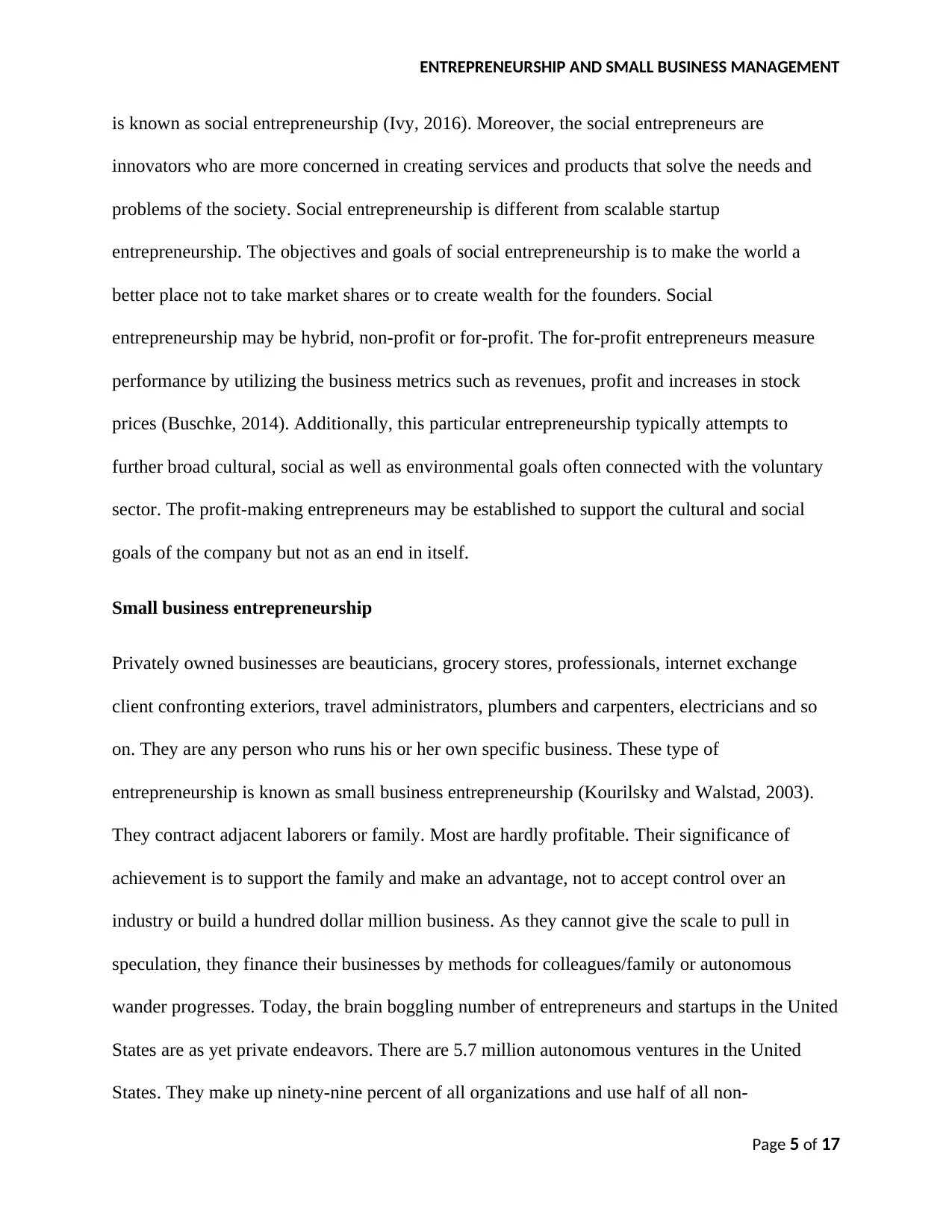
ENTREPRENEURSHIP AND SMALL BUSINESS MANAGEMENT
is known as social entrepreneurship (Ivy, 2016). Moreover, the social entrepreneurs are
innovators who are more concerned in creating services and products that solve the needs and
problems of the society. Social entrepreneurship is different from scalable startup
entrepreneurship. The objectives and goals of social entrepreneurship is to make the world a
better place not to take market shares or to create wealth for the founders. Social
entrepreneurship may be hybrid, non-profit or for-profit. The for-profit entrepreneurs measure
performance by utilizing the business metrics such as revenues, profit and increases in stock
prices (Buschke, 2014). Additionally, this particular entrepreneurship typically attempts to
further broad cultural, social as well as environmental goals often connected with the voluntary
sector. The profit-making entrepreneurs may be established to support the cultural and social
goals of the company but not as an end in itself.
Small business entrepreneurship
Privately owned businesses are beauticians, grocery stores, professionals, internet exchange
client confronting exteriors, travel administrators, plumbers and carpenters, electricians and so
on. They are any person who runs his or her own specific business. These type of
entrepreneurship is known as small business entrepreneurship (Kourilsky and Walstad, 2003).
They contract adjacent laborers or family. Most are hardly profitable. Their significance of
achievement is to support the family and make an advantage, not to accept control over an
industry or build a hundred dollar million business. As they cannot give the scale to pull in
speculation, they finance their businesses by methods for colleagues/family or autonomous
wander progresses. Today, the brain boggling number of entrepreneurs and startups in the United
States are as yet private endeavors. There are 5.7 million autonomous ventures in the United
States. They make up ninety-nine percent of all organizations and use half of all non-
Page 5 of 17
is known as social entrepreneurship (Ivy, 2016). Moreover, the social entrepreneurs are
innovators who are more concerned in creating services and products that solve the needs and
problems of the society. Social entrepreneurship is different from scalable startup
entrepreneurship. The objectives and goals of social entrepreneurship is to make the world a
better place not to take market shares or to create wealth for the founders. Social
entrepreneurship may be hybrid, non-profit or for-profit. The for-profit entrepreneurs measure
performance by utilizing the business metrics such as revenues, profit and increases in stock
prices (Buschke, 2014). Additionally, this particular entrepreneurship typically attempts to
further broad cultural, social as well as environmental goals often connected with the voluntary
sector. The profit-making entrepreneurs may be established to support the cultural and social
goals of the company but not as an end in itself.
Small business entrepreneurship
Privately owned businesses are beauticians, grocery stores, professionals, internet exchange
client confronting exteriors, travel administrators, plumbers and carpenters, electricians and so
on. They are any person who runs his or her own specific business. These type of
entrepreneurship is known as small business entrepreneurship (Kourilsky and Walstad, 2003).
They contract adjacent laborers or family. Most are hardly profitable. Their significance of
achievement is to support the family and make an advantage, not to accept control over an
industry or build a hundred dollar million business. As they cannot give the scale to pull in
speculation, they finance their businesses by methods for colleagues/family or autonomous
wander progresses. Today, the brain boggling number of entrepreneurs and startups in the United
States are as yet private endeavors. There are 5.7 million autonomous ventures in the United
States. They make up ninety-nine percent of all organizations and use half of all non-
Page 5 of 17
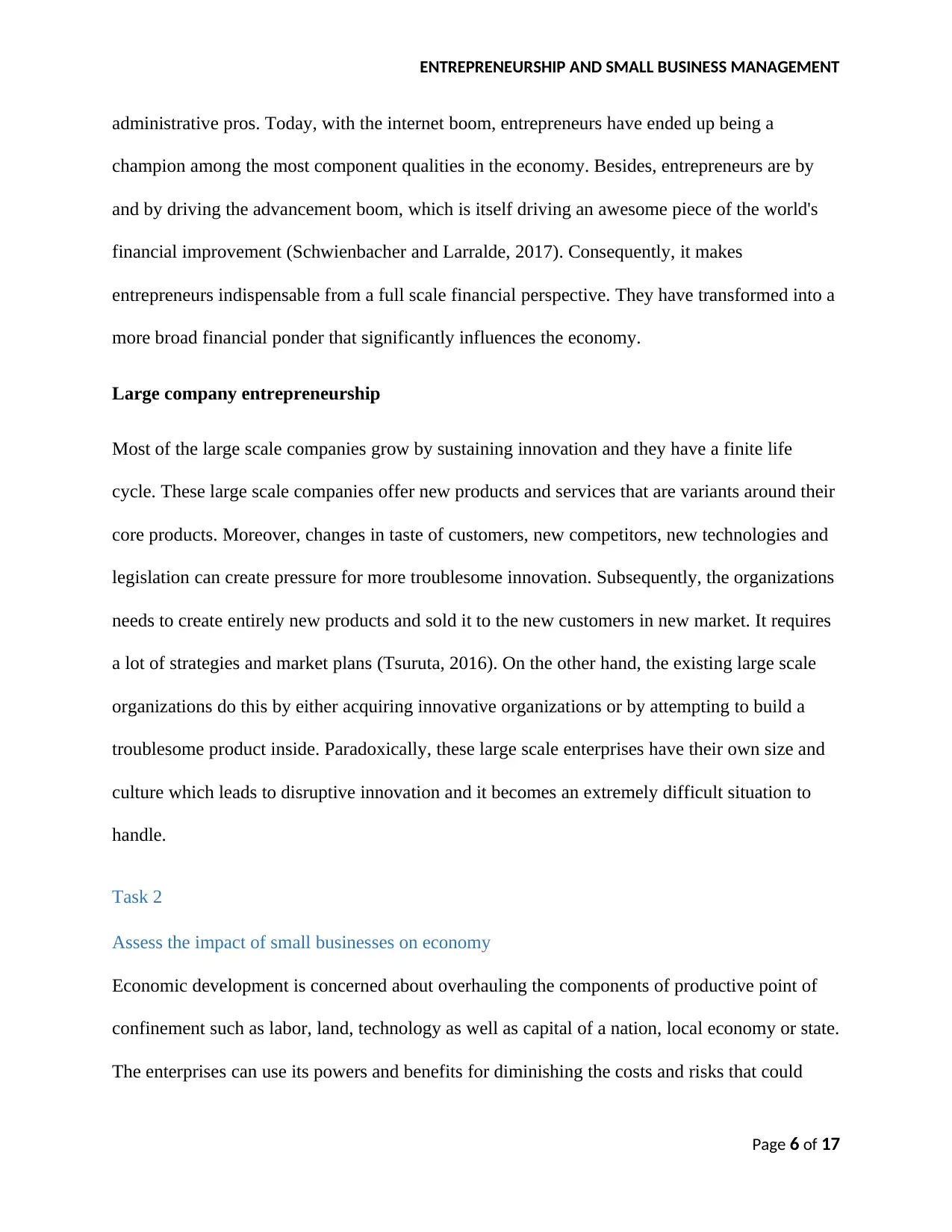
ENTREPRENEURSHIP AND SMALL BUSINESS MANAGEMENT
administrative pros. Today, with the internet boom, entrepreneurs have ended up being a
champion among the most component qualities in the economy. Besides, entrepreneurs are by
and by driving the advancement boom, which is itself driving an awesome piece of the world's
financial improvement (Schwienbacher and Larralde, 2017). Consequently, it makes
entrepreneurs indispensable from a full scale financial perspective. They have transformed into a
more broad financial ponder that significantly influences the economy.
Large company entrepreneurship
Most of the large scale companies grow by sustaining innovation and they have a finite life
cycle. These large scale companies offer new products and services that are variants around their
core products. Moreover, changes in taste of customers, new competitors, new technologies and
legislation can create pressure for more troublesome innovation. Subsequently, the organizations
needs to create entirely new products and sold it to the new customers in new market. It requires
a lot of strategies and market plans (Tsuruta, 2016). On the other hand, the existing large scale
organizations do this by either acquiring innovative organizations or by attempting to build a
troublesome product inside. Paradoxically, these large scale enterprises have their own size and
culture which leads to disruptive innovation and it becomes an extremely difficult situation to
handle.
Task 2
Assess the impact of small businesses on economy
Economic development is concerned about overhauling the components of productive point of
confinement such as labor, land, technology as well as capital of a nation, local economy or state.
The enterprises can use its powers and benefits for diminishing the costs and risks that could
Page 6 of 17
administrative pros. Today, with the internet boom, entrepreneurs have ended up being a
champion among the most component qualities in the economy. Besides, entrepreneurs are by
and by driving the advancement boom, which is itself driving an awesome piece of the world's
financial improvement (Schwienbacher and Larralde, 2017). Consequently, it makes
entrepreneurs indispensable from a full scale financial perspective. They have transformed into a
more broad financial ponder that significantly influences the economy.
Large company entrepreneurship
Most of the large scale companies grow by sustaining innovation and they have a finite life
cycle. These large scale companies offer new products and services that are variants around their
core products. Moreover, changes in taste of customers, new competitors, new technologies and
legislation can create pressure for more troublesome innovation. Subsequently, the organizations
needs to create entirely new products and sold it to the new customers in new market. It requires
a lot of strategies and market plans (Tsuruta, 2016). On the other hand, the existing large scale
organizations do this by either acquiring innovative organizations or by attempting to build a
troublesome product inside. Paradoxically, these large scale enterprises have their own size and
culture which leads to disruptive innovation and it becomes an extremely difficult situation to
handle.
Task 2
Assess the impact of small businesses on economy
Economic development is concerned about overhauling the components of productive point of
confinement such as labor, land, technology as well as capital of a nation, local economy or state.
The enterprises can use its powers and benefits for diminishing the costs and risks that could
Page 6 of 17
⊘ This is a preview!⊘
Do you want full access?
Subscribe today to unlock all pages.

Trusted by 1+ million students worldwide
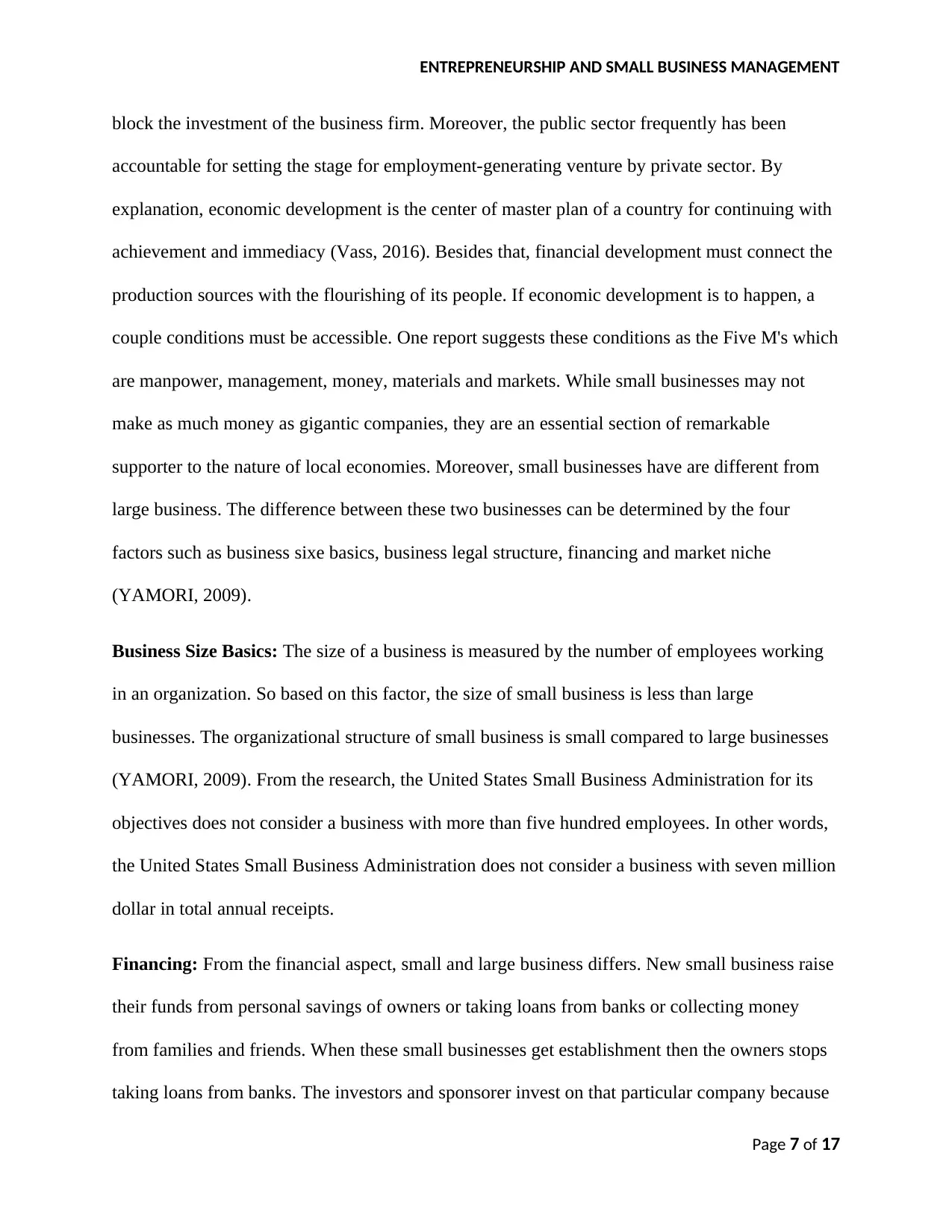
ENTREPRENEURSHIP AND SMALL BUSINESS MANAGEMENT
block the investment of the business firm. Moreover, the public sector frequently has been
accountable for setting the stage for employment-generating venture by private sector. By
explanation, economic development is the center of master plan of a country for continuing with
achievement and immediacy (Vass, 2016). Besides that, financial development must connect the
production sources with the flourishing of its people. If economic development is to happen, a
couple conditions must be accessible. One report suggests these conditions as the Five M's which
are manpower, management, money, materials and markets. While small businesses may not
make as much money as gigantic companies, they are an essential section of remarkable
supporter to the nature of local economies. Moreover, small businesses have are different from
large business. The difference between these two businesses can be determined by the four
factors such as business sixe basics, business legal structure, financing and market niche
(YAMORI, 2009).
Business Size Basics: The size of a business is measured by the number of employees working
in an organization. So based on this factor, the size of small business is less than large
businesses. The organizational structure of small business is small compared to large businesses
(YAMORI, 2009). From the research, the United States Small Business Administration for its
objectives does not consider a business with more than five hundred employees. In other words,
the United States Small Business Administration does not consider a business with seven million
dollar in total annual receipts.
Financing: From the financial aspect, small and large business differs. New small business raise
their funds from personal savings of owners or taking loans from banks or collecting money
from families and friends. When these small businesses get establishment then the owners stops
taking loans from banks. The investors and sponsorer invest on that particular company because
Page 7 of 17
block the investment of the business firm. Moreover, the public sector frequently has been
accountable for setting the stage for employment-generating venture by private sector. By
explanation, economic development is the center of master plan of a country for continuing with
achievement and immediacy (Vass, 2016). Besides that, financial development must connect the
production sources with the flourishing of its people. If economic development is to happen, a
couple conditions must be accessible. One report suggests these conditions as the Five M's which
are manpower, management, money, materials and markets. While small businesses may not
make as much money as gigantic companies, they are an essential section of remarkable
supporter to the nature of local economies. Moreover, small businesses have are different from
large business. The difference between these two businesses can be determined by the four
factors such as business sixe basics, business legal structure, financing and market niche
(YAMORI, 2009).
Business Size Basics: The size of a business is measured by the number of employees working
in an organization. So based on this factor, the size of small business is less than large
businesses. The organizational structure of small business is small compared to large businesses
(YAMORI, 2009). From the research, the United States Small Business Administration for its
objectives does not consider a business with more than five hundred employees. In other words,
the United States Small Business Administration does not consider a business with seven million
dollar in total annual receipts.
Financing: From the financial aspect, small and large business differs. New small business raise
their funds from personal savings of owners or taking loans from banks or collecting money
from families and friends. When these small businesses get establishment then the owners stops
taking loans from banks. The investors and sponsorer invest on that particular company because
Page 7 of 17
Paraphrase This Document
Need a fresh take? Get an instant paraphrase of this document with our AI Paraphraser
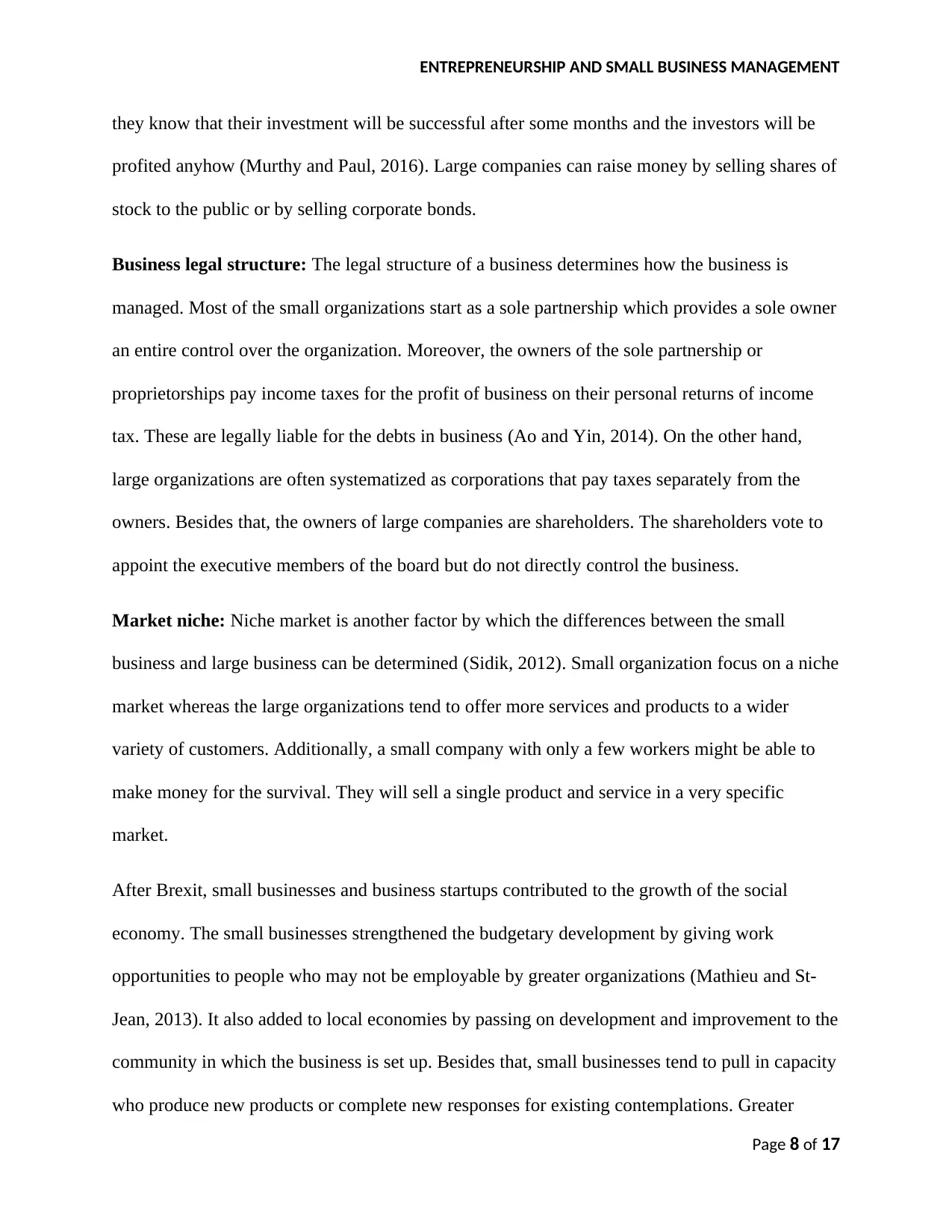
ENTREPRENEURSHIP AND SMALL BUSINESS MANAGEMENT
they know that their investment will be successful after some months and the investors will be
profited anyhow (Murthy and Paul, 2016). Large companies can raise money by selling shares of
stock to the public or by selling corporate bonds.
Business legal structure: The legal structure of a business determines how the business is
managed. Most of the small organizations start as a sole partnership which provides a sole owner
an entire control over the organization. Moreover, the owners of the sole partnership or
proprietorships pay income taxes for the profit of business on their personal returns of income
tax. These are legally liable for the debts in business (Ao and Yin, 2014). On the other hand,
large organizations are often systematized as corporations that pay taxes separately from the
owners. Besides that, the owners of large companies are shareholders. The shareholders vote to
appoint the executive members of the board but do not directly control the business.
Market niche: Niche market is another factor by which the differences between the small
business and large business can be determined (Sidik, 2012). Small organization focus on a niche
market whereas the large organizations tend to offer more services and products to a wider
variety of customers. Additionally, a small company with only a few workers might be able to
make money for the survival. They will sell a single product and service in a very specific
market.
After Brexit, small businesses and business startups contributed to the growth of the social
economy. The small businesses strengthened the budgetary development by giving work
opportunities to people who may not be employable by greater organizations (Mathieu and St-
Jean, 2013). It also added to local economies by passing on development and improvement to the
community in which the business is set up. Besides that, small businesses tend to pull in capacity
who produce new products or complete new responses for existing contemplations. Greater
Page 8 of 17
they know that their investment will be successful after some months and the investors will be
profited anyhow (Murthy and Paul, 2016). Large companies can raise money by selling shares of
stock to the public or by selling corporate bonds.
Business legal structure: The legal structure of a business determines how the business is
managed. Most of the small organizations start as a sole partnership which provides a sole owner
an entire control over the organization. Moreover, the owners of the sole partnership or
proprietorships pay income taxes for the profit of business on their personal returns of income
tax. These are legally liable for the debts in business (Ao and Yin, 2014). On the other hand,
large organizations are often systematized as corporations that pay taxes separately from the
owners. Besides that, the owners of large companies are shareholders. The shareholders vote to
appoint the executive members of the board but do not directly control the business.
Market niche: Niche market is another factor by which the differences between the small
business and large business can be determined (Sidik, 2012). Small organization focus on a niche
market whereas the large organizations tend to offer more services and products to a wider
variety of customers. Additionally, a small company with only a few workers might be able to
make money for the survival. They will sell a single product and service in a very specific
market.
After Brexit, small businesses and business startups contributed to the growth of the social
economy. The small businesses strengthened the budgetary development by giving work
opportunities to people who may not be employable by greater organizations (Mathieu and St-
Jean, 2013). It also added to local economies by passing on development and improvement to the
community in which the business is set up. Besides that, small businesses tend to pull in capacity
who produce new products or complete new responses for existing contemplations. Greater
Page 8 of 17
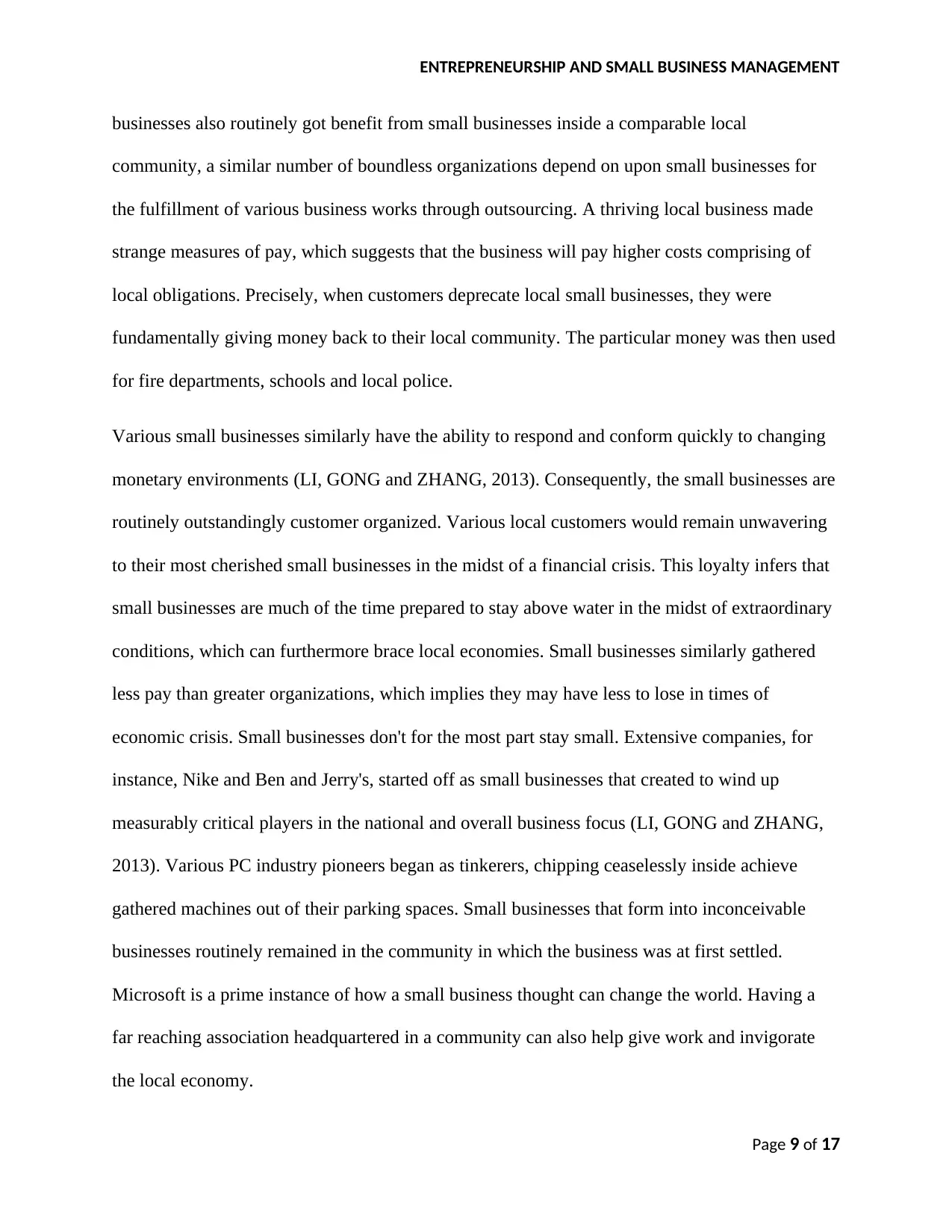
ENTREPRENEURSHIP AND SMALL BUSINESS MANAGEMENT
businesses also routinely got benefit from small businesses inside a comparable local
community, a similar number of boundless organizations depend on upon small businesses for
the fulfillment of various business works through outsourcing. A thriving local business made
strange measures of pay, which suggests that the business will pay higher costs comprising of
local obligations. Precisely, when customers deprecate local small businesses, they were
fundamentally giving money back to their local community. The particular money was then used
for fire departments, schools and local police.
Various small businesses similarly have the ability to respond and conform quickly to changing
monetary environments (LI, GONG and ZHANG, 2013). Consequently, the small businesses are
routinely outstandingly customer organized. Various local customers would remain unwavering
to their most cherished small businesses in the midst of a financial crisis. This loyalty infers that
small businesses are much of the time prepared to stay above water in the midst of extraordinary
conditions, which can furthermore brace local economies. Small businesses similarly gathered
less pay than greater organizations, which implies they may have less to lose in times of
economic crisis. Small businesses don't for the most part stay small. Extensive companies, for
instance, Nike and Ben and Jerry's, started off as small businesses that created to wind up
measurably critical players in the national and overall business focus (LI, GONG and ZHANG,
2013). Various PC industry pioneers began as tinkerers, chipping ceaselessly inside achieve
gathered machines out of their parking spaces. Small businesses that form into inconceivable
businesses routinely remained in the community in which the business was at first settled.
Microsoft is a prime instance of how a small business thought can change the world. Having a
far reaching association headquartered in a community can also help give work and invigorate
the local economy.
Page 9 of 17
businesses also routinely got benefit from small businesses inside a comparable local
community, a similar number of boundless organizations depend on upon small businesses for
the fulfillment of various business works through outsourcing. A thriving local business made
strange measures of pay, which suggests that the business will pay higher costs comprising of
local obligations. Precisely, when customers deprecate local small businesses, they were
fundamentally giving money back to their local community. The particular money was then used
for fire departments, schools and local police.
Various small businesses similarly have the ability to respond and conform quickly to changing
monetary environments (LI, GONG and ZHANG, 2013). Consequently, the small businesses are
routinely outstandingly customer organized. Various local customers would remain unwavering
to their most cherished small businesses in the midst of a financial crisis. This loyalty infers that
small businesses are much of the time prepared to stay above water in the midst of extraordinary
conditions, which can furthermore brace local economies. Small businesses similarly gathered
less pay than greater organizations, which implies they may have less to lose in times of
economic crisis. Small businesses don't for the most part stay small. Extensive companies, for
instance, Nike and Ben and Jerry's, started off as small businesses that created to wind up
measurably critical players in the national and overall business focus (LI, GONG and ZHANG,
2013). Various PC industry pioneers began as tinkerers, chipping ceaselessly inside achieve
gathered machines out of their parking spaces. Small businesses that form into inconceivable
businesses routinely remained in the community in which the business was at first settled.
Microsoft is a prime instance of how a small business thought can change the world. Having a
far reaching association headquartered in a community can also help give work and invigorate
the local economy.
Page 9 of 17
⊘ This is a preview!⊘
Do you want full access?
Subscribe today to unlock all pages.

Trusted by 1+ million students worldwide
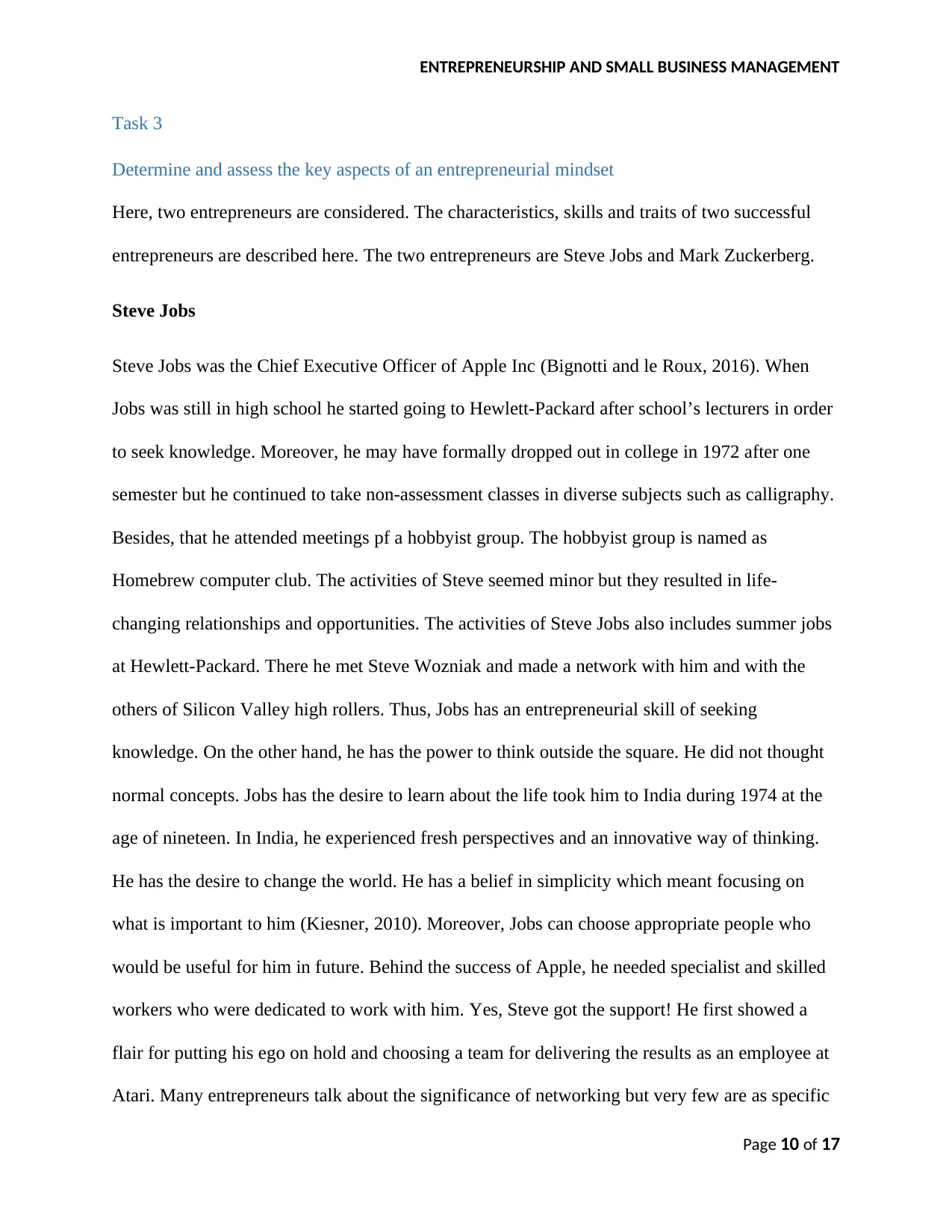
ENTREPRENEURSHIP AND SMALL BUSINESS MANAGEMENT
Task 3
Determine and assess the key aspects of an entrepreneurial mindset
Here, two entrepreneurs are considered. The characteristics, skills and traits of two successful
entrepreneurs are described here. The two entrepreneurs are Steve Jobs and Mark Zuckerberg.
Steve Jobs
Steve Jobs was the Chief Executive Officer of Apple Inc (Bignotti and le Roux, 2016). When
Jobs was still in high school he started going to Hewlett-Packard after school’s lecturers in order
to seek knowledge. Moreover, he may have formally dropped out in college in 1972 after one
semester but he continued to take non-assessment classes in diverse subjects such as calligraphy.
Besides, that he attended meetings pf a hobbyist group. The hobbyist group is named as
Homebrew computer club. The activities of Steve seemed minor but they resulted in life-
changing relationships and opportunities. The activities of Steve Jobs also includes summer jobs
at Hewlett-Packard. There he met Steve Wozniak and made a network with him and with the
others of Silicon Valley high rollers. Thus, Jobs has an entrepreneurial skill of seeking
knowledge. On the other hand, he has the power to think outside the square. He did not thought
normal concepts. Jobs has the desire to learn about the life took him to India during 1974 at the
age of nineteen. In India, he experienced fresh perspectives and an innovative way of thinking.
He has the desire to change the world. He has a belief in simplicity which meant focusing on
what is important to him (Kiesner, 2010). Moreover, Jobs can choose appropriate people who
would be useful for him in future. Behind the success of Apple, he needed specialist and skilled
workers who were dedicated to work with him. Yes, Steve got the support! He first showed a
flair for putting his ego on hold and choosing a team for delivering the results as an employee at
Atari. Many entrepreneurs talk about the significance of networking but very few are as specific
Page 10 of 17
Task 3
Determine and assess the key aspects of an entrepreneurial mindset
Here, two entrepreneurs are considered. The characteristics, skills and traits of two successful
entrepreneurs are described here. The two entrepreneurs are Steve Jobs and Mark Zuckerberg.
Steve Jobs
Steve Jobs was the Chief Executive Officer of Apple Inc (Bignotti and le Roux, 2016). When
Jobs was still in high school he started going to Hewlett-Packard after school’s lecturers in order
to seek knowledge. Moreover, he may have formally dropped out in college in 1972 after one
semester but he continued to take non-assessment classes in diverse subjects such as calligraphy.
Besides, that he attended meetings pf a hobbyist group. The hobbyist group is named as
Homebrew computer club. The activities of Steve seemed minor but they resulted in life-
changing relationships and opportunities. The activities of Steve Jobs also includes summer jobs
at Hewlett-Packard. There he met Steve Wozniak and made a network with him and with the
others of Silicon Valley high rollers. Thus, Jobs has an entrepreneurial skill of seeking
knowledge. On the other hand, he has the power to think outside the square. He did not thought
normal concepts. Jobs has the desire to learn about the life took him to India during 1974 at the
age of nineteen. In India, he experienced fresh perspectives and an innovative way of thinking.
He has the desire to change the world. He has a belief in simplicity which meant focusing on
what is important to him (Kiesner, 2010). Moreover, Jobs can choose appropriate people who
would be useful for him in future. Behind the success of Apple, he needed specialist and skilled
workers who were dedicated to work with him. Yes, Steve got the support! He first showed a
flair for putting his ego on hold and choosing a team for delivering the results as an employee at
Atari. Many entrepreneurs talk about the significance of networking but very few are as specific
Page 10 of 17
Paraphrase This Document
Need a fresh take? Get an instant paraphrase of this document with our AI Paraphraser

ENTREPRENEURSHIP AND SMALL BUSINESS MANAGEMENT
about how and why networking is important. Steve offered Wozniak half the reward to do the
technical work. In India, he was rewarded with hundred dollar for each chip he could remove
from an arcade game. It is obvious that Jobs knows how to build relationships with others
(Foster, 2017).
Mark Zuckerberg
The founder of the famous social networking site i.e. Facebook is Mark Zuckerberg. Currently,
he is one of the world’s most successful entrepreneurs. At the age of twenty-four he became the
youngest billionaire of the world. His website has now reached over more than nine hundred
million active users. Mark has many entrepreneur skills (Foster, 2017). At first, he truly believed
in what he was doing. It takes a lot of dedication to become successful in life by not just during
office hours. Mark is very dedicated towards his work. When Mark’s friends were out partying,
he stayed in his room and worked on coding for making his own website until early in the
morning. On the other hand, he is always prepared to take criticism. Mark Zuckerberg and his
team remained strong in the face of difficulty when Facebook has suffered its fair share of
setbacks. Moreover, he loves to dream big. Not very many individuals would set out to trust that
a venture they had begun in their school apartment would wind up turning into an overall marvel
(Van Ness and Seifert, 2015). While it is improbable that Mark Zuckerberg was going for one
billion clients from the very beginning, unmistakably he generally had huge thoughts regarding
his organization's prosperity and his general vision for what's to come. Apart from these, he is
not afraid to take great risks. When raising cash for Facebook, Zuckerberg went out on a limb a
progression of critical dangers. He disregarded real speculators, wiped out gatherings, and
overlooked essential telephone calls, just to drive up request. In the long run, he had twelve
substantial speculation organizations clamoring to store his site (Schjoedt, 2009). While the vast
Page 11 of 17
about how and why networking is important. Steve offered Wozniak half the reward to do the
technical work. In India, he was rewarded with hundred dollar for each chip he could remove
from an arcade game. It is obvious that Jobs knows how to build relationships with others
(Foster, 2017).
Mark Zuckerberg
The founder of the famous social networking site i.e. Facebook is Mark Zuckerberg. Currently,
he is one of the world’s most successful entrepreneurs. At the age of twenty-four he became the
youngest billionaire of the world. His website has now reached over more than nine hundred
million active users. Mark has many entrepreneur skills (Foster, 2017). At first, he truly believed
in what he was doing. It takes a lot of dedication to become successful in life by not just during
office hours. Mark is very dedicated towards his work. When Mark’s friends were out partying,
he stayed in his room and worked on coding for making his own website until early in the
morning. On the other hand, he is always prepared to take criticism. Mark Zuckerberg and his
team remained strong in the face of difficulty when Facebook has suffered its fair share of
setbacks. Moreover, he loves to dream big. Not very many individuals would set out to trust that
a venture they had begun in their school apartment would wind up turning into an overall marvel
(Van Ness and Seifert, 2015). While it is improbable that Mark Zuckerberg was going for one
billion clients from the very beginning, unmistakably he generally had huge thoughts regarding
his organization's prosperity and his general vision for what's to come. Apart from these, he is
not afraid to take great risks. When raising cash for Facebook, Zuckerberg went out on a limb a
progression of critical dangers. He disregarded real speculators, wiped out gatherings, and
overlooked essential telephone calls, just to drive up request. In the long run, he had twelve
substantial speculation organizations clamoring to store his site (Schjoedt, 2009). While the vast
Page 11 of 17
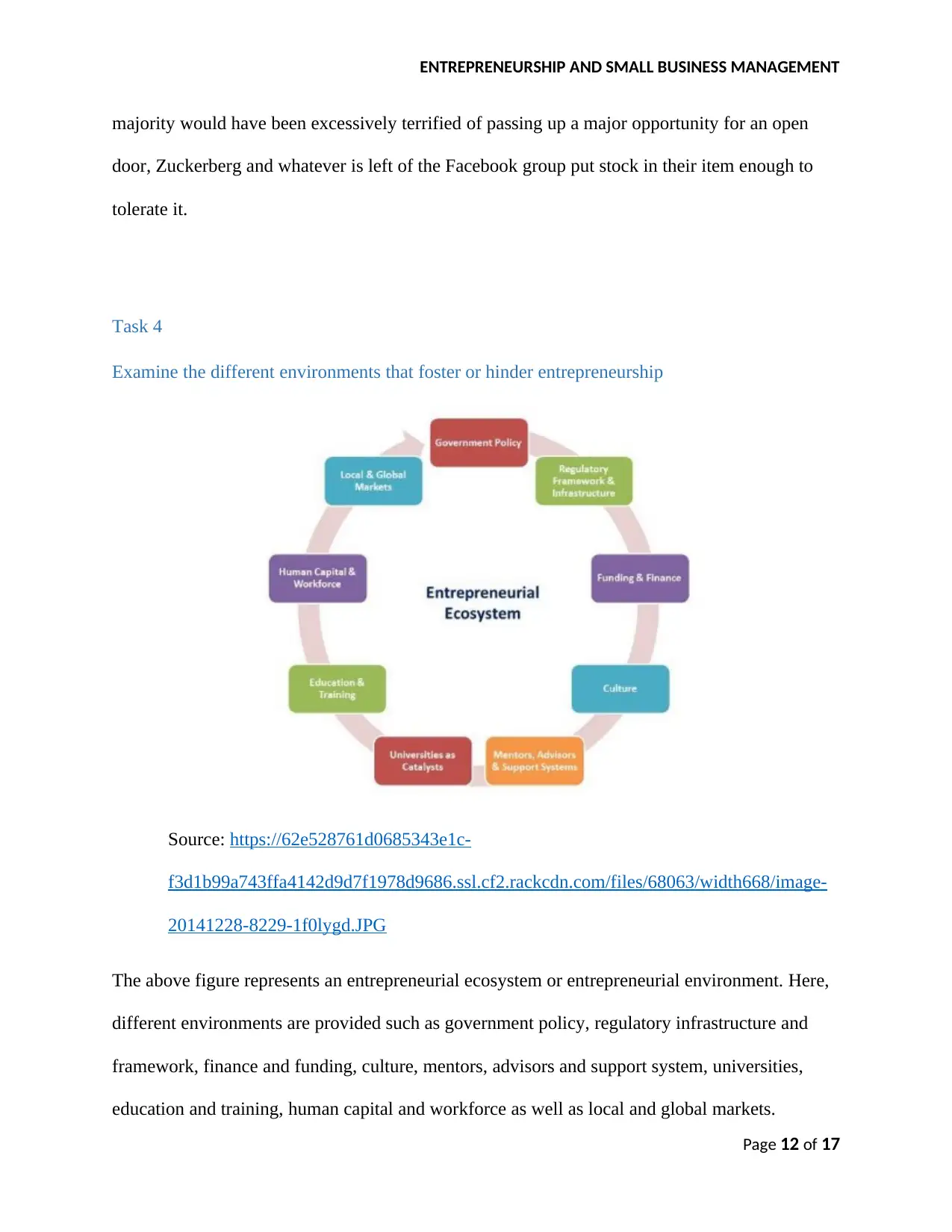
ENTREPRENEURSHIP AND SMALL BUSINESS MANAGEMENT
majority would have been excessively terrified of passing up a major opportunity for an open
door, Zuckerberg and whatever is left of the Facebook group put stock in their item enough to
tolerate it.
Task 4
Examine the different environments that foster or hinder entrepreneurship
Source: https://62e528761d0685343e1c-
f3d1b99a743ffa4142d9d7f1978d9686.ssl.cf2.rackcdn.com/files/68063/width668/image-
20141228-8229-1f0lygd.JPG
The above figure represents an entrepreneurial ecosystem or entrepreneurial environment. Here,
different environments are provided such as government policy, regulatory infrastructure and
framework, finance and funding, culture, mentors, advisors and support system, universities,
education and training, human capital and workforce as well as local and global markets.
Page 12 of 17
majority would have been excessively terrified of passing up a major opportunity for an open
door, Zuckerberg and whatever is left of the Facebook group put stock in their item enough to
tolerate it.
Task 4
Examine the different environments that foster or hinder entrepreneurship
Source: https://62e528761d0685343e1c-
f3d1b99a743ffa4142d9d7f1978d9686.ssl.cf2.rackcdn.com/files/68063/width668/image-
20141228-8229-1f0lygd.JPG
The above figure represents an entrepreneurial ecosystem or entrepreneurial environment. Here,
different environments are provided such as government policy, regulatory infrastructure and
framework, finance and funding, culture, mentors, advisors and support system, universities,
education and training, human capital and workforce as well as local and global markets.
Page 12 of 17
⊘ This is a preview!⊘
Do you want full access?
Subscribe today to unlock all pages.

Trusted by 1+ million students worldwide
1 out of 17
Related Documents
Your All-in-One AI-Powered Toolkit for Academic Success.
+13062052269
info@desklib.com
Available 24*7 on WhatsApp / Email
![[object Object]](/_next/static/media/star-bottom.7253800d.svg)
Unlock your academic potential
Copyright © 2020–2025 A2Z Services. All Rights Reserved. Developed and managed by ZUCOL.




